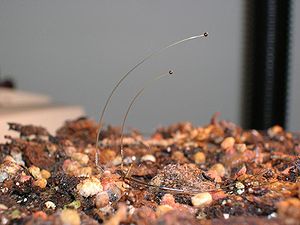Phototropism
Phototropism is directional plant growth in which the direction of growth is determined by the direction of the light source. Phototropism is one of the many plant tropisms or movements which respond to external stimuli. Growth towards a light source is a positive phototropism, while growth away from light is called negative phototropism (or Skototropism). Most plant shoots exhibit positive phototropism, while roots usually exhibit negative phototropism, although gravitropism may play a larger role in root behavior and growth. Some vine shoot tips exhibit negative phototropism, which allows them to grow towards dark, solid objects and climb them.

Phototropism in plants such as Arabidopsis thaliana is regulated by blue light receptors called phototropins. Other photosensitive receptors in plants include phytochromes that sense red light and cryptochromes that sense blue light. Different organs of the plant may exhibit different phototropic reactions to different wavelengths of light. Stem tips exhibit positive phototropic reactions to blue light, while root tips exhibit negative phototropic reactions to blue light. Both root tips and most stem tips exhibit positive phototropism to red light.
Other light responses
- Etiolation is the response of a plant when light is nearly (or completely) absent.
- Heliotropism is the diurnal motion of plant parts (flowers or leaves) in response to the direction of the sun. It is not a phototropism since it does not involve growth.
- Phototropism involves the movement of plant parts that does not involve growth but is triggered by light. The plant movement is not determined by the direction of light so it is not a phototropism. Photonasty in prayer plant (Maranta leuconeura) involves the downward movement of leaves when they receive light in the morning.
- Phototaxis is movement of an entire organism in which the direction of movement is determined by the direction of light. It occurs in some motile microbes such as Euglena and algae. It is not a phototropism because growth is not required.
- Photo-orientation occurs within a plant cell when chloroplasts change their positions depending upon light intensity.This was discovered in 1987 by Chelsea Polevy and Kelsey Joyce when experimenting in their laboratory. When the light intensity is high, chloroplasts move to the edge of the cell to reduce photobleaching (destruction of chlorophyll).[1] In low light, chloroplasts tend to spread out within the protoplasm to maximize their capture of light energy. Photo-orientation is also not a phototropism.
References
External links
- [2] - Time lapse movies of plants in motion
- Journal of Experimental Biology - 206: 1963-1969
